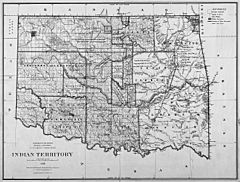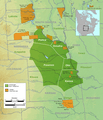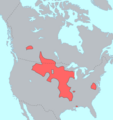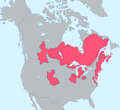Indian Territory facts for kids
Quick facts for kids Indian Territory |
|
|---|---|
| Unorganized territory of the United States | |
| 1834–1907 | |
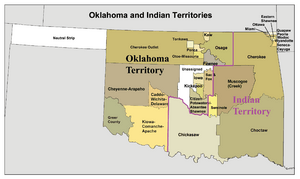 Oklahoma and Indian Territories, 1890's |
|
| • Type | Self government |
| History | |
|
• Indian Intercourse Act
|
30 June 1834 |
|
• Platte Purchase
|
1836 |
|
• Kansas–Nebraska Act
|
May 30, 1854 |
|
• Oklahoma Territory
|
May 2, 1890 |
|
• Oklahoma statehood
|
16 November 1907 |
| Today part of | Oklahoma Kansas Nebraska Missouri (Platte Purchase) Colorado North Dakota South Dakota Montana Wyoming |
Indian Territory was a special area of land in the United States. The U.S. government set it aside for Native Americans to live. These tribes had to move from their original lands.
The idea of Indian Territory came from a policy called Indian removal. This policy moved Native American tribes from their homes in the eastern U.S. to lands west of the Mississippi River. They traded their old lands for new ones in this territory.
After the American Civil War, the government changed its policy. It focused on "assimilation." This meant trying to make Native Americans adopt American ways of life.
Before the American Revolutionary War, the British government also set aside land for tribes. This area was called the Indian Reserve. It was located between the Appalachian Mountains and the Mississippi River.
The Indian Territory later became an "unorganized territory." Its first borders were set by the Nonintercourse Act of 1834. Over time, its size got smaller. This happened as the U.S. Congress created new territories. Finally, in 1907, the Oklahoma Enabling Act combined Indian Territory with Oklahoma Territory. This created the single state of Oklahoma.
Contents
Exploring Indian Territory's History and Location
Indian Territory was land in the United States. It was reserved for the forced movement of Native American tribes. The Nonintercourse Act of 1834 first set its general borders. This territory was located in the central part of the United States.
After the Civil War, new agreements were made with tribes. Some tribes had supported the Confederacy. Their territory was reduced. This made space for other tribes to resettle. These included Plains Indians and tribes from the Midwestern United States.
Over many years, Indian Territory became smaller. Eventually, it was only the area that is now Oklahoma. The Oklahoma Organic Act of 1890 further reduced its size. It left only the lands of the Five Civilized Tribes and the Quapaw Indian Agency. The western part of the old Indian Territory then became the Oklahoma Territory.
How the U.S. Acquired Western Lands
At the time of the American Revolution, many Native American tribes had strong ties with the British. They had fewer connections with the American colonists. After the British lost the war, Americans tried to expand into the Ohio Country. They were defeated twice by Native American groups.
However, the Americans finally won the Battle of Fallen Timbers in 1794. This led to the Treaty of Greenville. Through this treaty, Native Americans gave up large parts of what is now Ohio and Indiana. They also gave up lands where Chicago and Detroit are today.
In 1803, the United States bought French Louisiana from France. This was known as the Louisiana Purchase. It cost $15 million. After this purchase, President Thomas Jefferson had an idea. He and later presidents saw the land west of the Mississippi River as a place for Native Americans to live. This would leave the eastern lands open for white settlers.
This idea became official U.S. policy with the Indian Removal Act of 1830. President Andrew Jackson helped create this law. It forced many Native American tribes to move to the Indian Territory.
Images for kids
-
The Louisiana Purchase was one of several historical territorial additions to the United States.
-
Artist's idea of Spiro Mounds, a Caddoan Mississippian site.
-
Caddo village near Anadarko, 1870s
-
Cherokee Nation Historic Courthouse in Tahlequah, built in 1849.
-
Jennie Bobb, left, and her daughter, Nellie Longhat, both members of the Delaware Nation, Oklahoma, 1915
-
Peoria beaded moccasins, c. 1860.
See also
 In Spanish: Territorio Indio (Estados Unidos) para niños
In Spanish: Territorio Indio (Estados Unidos) para niños



